I was traveling last week to attend two events: Solutions Linux in Paris and LinuxTag in Berlin. It was a bit unfortunate that they happened during the same week, as they conflicted for two days — which means I missed some days for both events. And on top of that, the Ubuntu Developer Summit was also last week, which resulted in some people missing the events...
Compared to last year, both events had a quite visible difference in terms of number of visitors. I'm not exactly sure why this is so; it could be because there were conflicts with other events, or also because they moved to first half of May, which is different from previous years.
What was most amazing, however, was to be present at booths just one month after the GNOME 3.0 release. For both events, we had tons of GNOME 3 PromoDVDs (kindly offered on behalf of the openSUSE project) to give away, and that was a big success: I think we gave around 600 of them at Solutions Linux and probably a similar amount, if not more, at LinuxTag (Tobias would know better than me here).
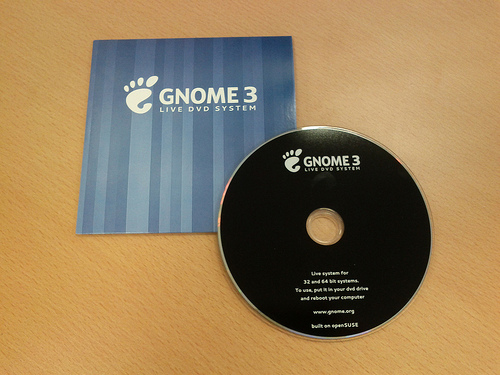
GNOME 3 PromoDVD. Picture by Frédéric Crozat
Many more people than usual came to us to talk about GNOME 3 and the feedback was very positive in most cases (except for kernel hackers, interestingly). Even if visitors loved the fact that it's intuitive and shiny, I believe what many loved even more was the innovation that the GNOME project has put in GNOME 3. It was also eye-opening to realize how many people were interested in looking at and playing with the internals of GNOME Shell, and considering writing an extension to cover that small thing they were deeply missing — until we usually showed them that there was already an extension for what they wanted.
We didn't have an event box for the GNOME booth at Solutions Linux since we weren't sure there would always be someone on the booth during the three days, but in addition to the PromoDVDs, we had many t-shirts from FOSDEM. Many thanks to Alexandre Franke, Michael Scherer and Christophe Fergeau for doing most of the work at Solutions Linux.
On the other hand, at LinuxTag, Tobias made use of the two European event boxes to make sure that, after last year where we had no presence at the event, GNOME would be rocking hard there. And I must admit it worked pretty well!
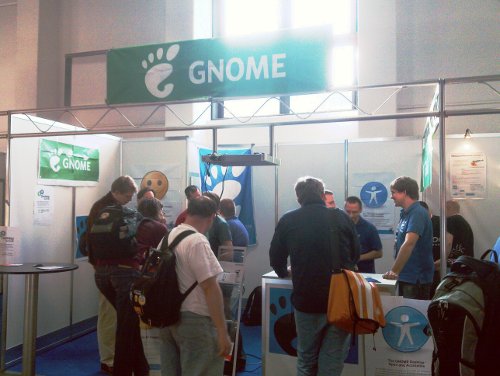
GNOME Booth at LinuxTag. Picture by Tobias Mueller
On the openSUSE side, Henne cheated with magic to organize an incredible presence at LinuxTag. We had something like 30 people, and the booth was always full of people willing to answer questions or help visitors. While it was not needed to attract people, we also had some of our openSUSE beer to distribute around.
It's really interesting to compare memories of the LinuxTag events I attended, and the most visible difference is how people perceive the project: it now feels like openSUSE is really considered as a community project by everyone we're talking to while this was much less obvious in 2008. Apparently, we're doing something right :-)
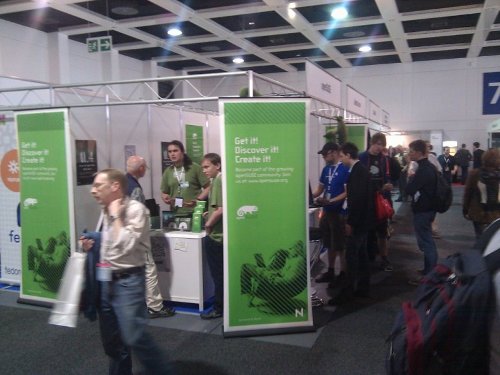
openSUSE Booth at LinuxTag. Picture by Michal Hrušecký
Going to Berlin was also a great opportunity to catch up with the other boosters and many friends. It was a bit short, but I was glad to be able to use some brain time from great minds like Stefano (from Debian), Bradley (from Software Freedom Conservancy) or Andreas (here at openSUSE), to just name a few. Pavol and I investigated further how to deal with the GSoC money for openSUSE without the openSUSE Foundation, and the event was a nice opportunity to discuss this with other people to help us move forward. Finally, I was able to put a face on the name of our latest booster who joined the team recently, İsmail, so now I really know whom I'm annoying every day ;-)
Since I apparently can't go to events without delivering some talks, I had three slots to publicly digress about some topics during the week:
- for Solutions Linux, it's always hard to find appropriate topics as this is not the typical audience I'm used to; the people attending the talks are usually much more interested in the business side of things, and in how technologies can benefit their companies. In the end, I chose to talk about SUSE Studio since it offers an extremely intuitive interface based on great technologies to build appliances. And it's so cool that it makes it easy to talk about it :-)
- my first talk at LinuxTag was about cross-distribution collaboration. That's a topic that I'm getting fond of after discovering that we could do much more in this area, and there's nothing blocking more collaboration except people not talking to each other. There are some success stories of collaboration (with some that are really long-standing), but there are also failures. Those failures should however not prevent us from trying again and again, as long as we learn from them. There was some good discussion with Sebastian Pipping from Gentoo about this, so this will hopefully result in even more contacts with Gentoo in this area.
- my second talk at LinuxTag was about GNOME 3. I really enjoy talking about GNOME 3, as we do have a great story to tell there and people are excited about this new version. While GNOME 3.0 could fill a full presentation slot, I like to go beyond and discuss about how we evolved as a community and what will come during the whole GNOME 3 era. Many thanks to my German friend, Daniel Siegel, who helped demo the instant messaging integration in the Shell during the talk; he also provided me with a nice topic to discuss with the audience, while doing a demo :-)
But the best thing of the week was that Klaas brought me some of his Blütenhonig. I've been wanting to get some for months (I think we first talked about it at FOSDEM 2010?), so I was really curious about it; therefore it's no surprise that it was one of the first things I ate when I came home, and it tastes great! I'll need more soon :-)



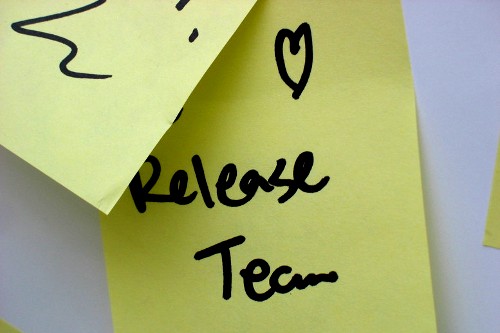
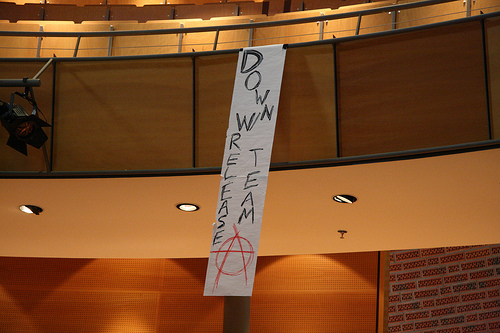
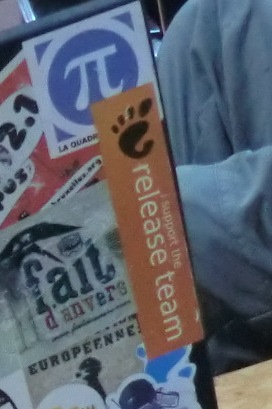
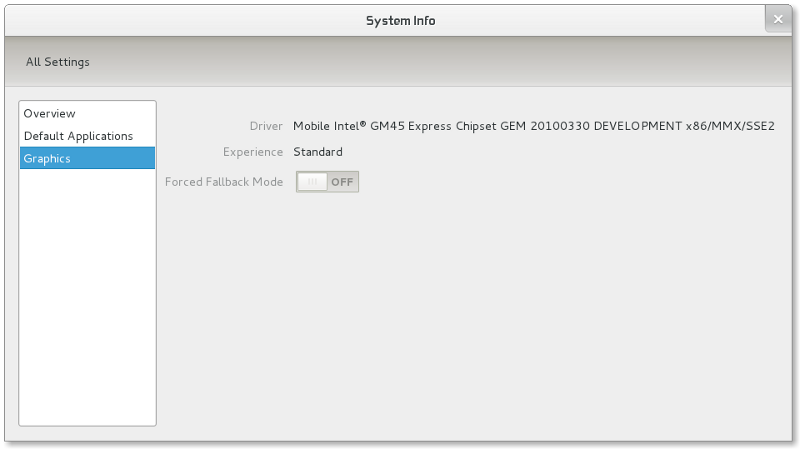
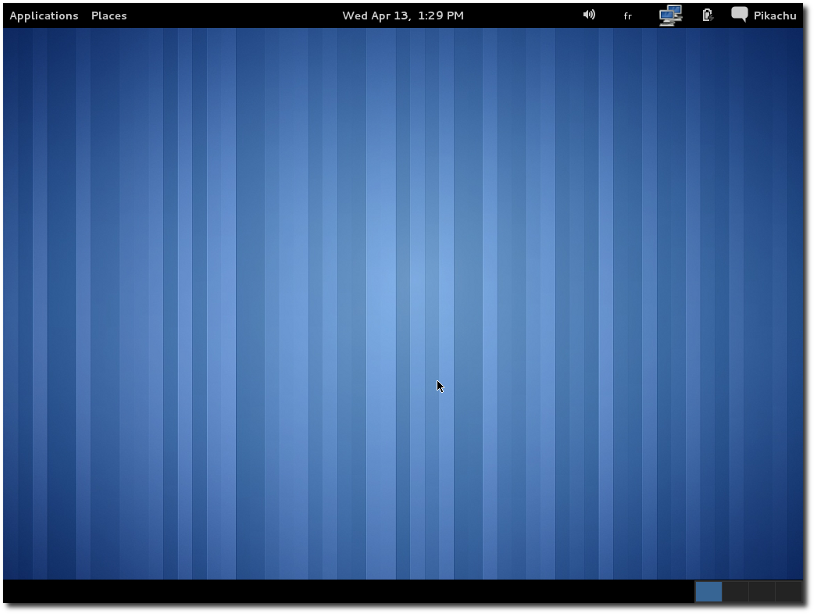
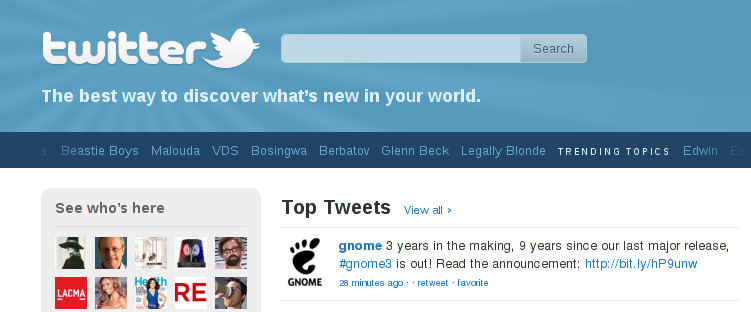
Last Comments